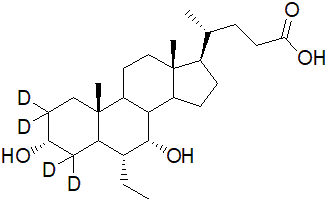| Description |
The Farnesoid X receptor (FXR) is a type of nuclear receptor activated by bile acids, with chenodeoxycholic acid (CDCA) serving as a prominent natural ligand [1]. 6-ECDCA, a synthetic bile acid, acts as a potent and selective agonist of FXR with an EC50 of 99 nM [2]. Through FXR activation, it modulates gene expression, providing protection against cholestasis and liver fibrosis in various animal models [2, 3, 4]. Additionally, 6-ECDCA influences adipocyte differentiation and enhances insulin signaling in mature adipocytes via FXR [5]. In ApoE-/- mice, 6-ECDCA has shown efficacy in mitigating vascular calcification associated with chronic kidney disease, while not affecting atherosclerosis development [6].
|
| Reference |
1. Rizzo, G., Renga, B., Antonelli, E., et al. The methyl transferase PRMT1 functions as co-activator of farnesoid X receptor (FXR)/9-cis retinoid X receptor and regulates transcription of FXR responsive genes. Mol. Pharmacol. 68(2), 551-558 (2005).
2. Pellicciari, R., Fiorucci, S., Camaioni, E., et al. 6α-ethyl-chenodeoxycholic acid (6-ECDCA), a potent and selective FXR agonist endowed with anticholestatic activity. J. Med. Chem. 45(17), 3569-3572 (2002).
3. Fiorucci, S., Clerici, C., Antonelli, E., et al. Protective effects of 6-ethyl chenodeoxycholic acid, a farnesoid X receptor ligand, in estrogen-induced cholestasis. J. Pharmacol. Exp. Ther. 313(2), 604-612 (2005).
4. Fiorucci, S., Rizzo, G., Antonelli, E., et al. A farnesoid X receptor-small heterodimer partner regulatory cascade modulates tissue metalloproteinase inhibitor-1 and matrix metalloprotease expression in hepatic stellate cells and promotes resolution of liver fibrosis. J. Pharmacol. Exp. Ther. 314(2), 584-595 (2005).
5. Rizzo, G., Disante, M., Mencarelli, A., et al. The Farnesoid X receptor promotes adipocyte differentiation and regulates adipose cell function in vivo. Mol. Pharmacol. 70(4), 1164-1173 (2006).
6. Miyazaki-Anzai, S., Levi, M., Kratzer, A., et al. Farnesoid X receptor activation prevents the development of vascular calcification in ApoE-/- mice with chronic kidney disease. Circ. Res. 106(12), 1807-1817 (2010).
|





